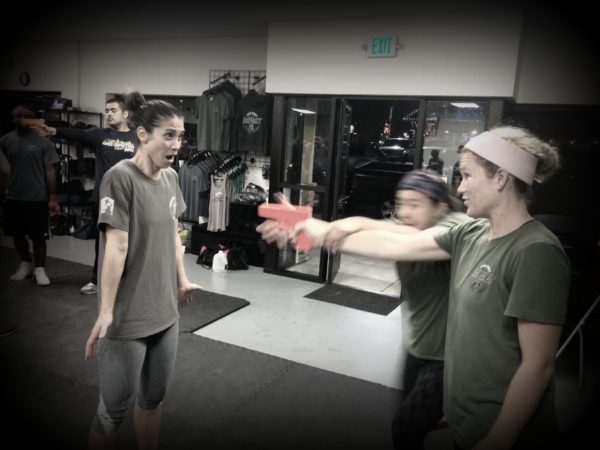

Learning how to protect others
Training Krav Maga is more than just learning basic self-defense skills. In fact Krav Maga focuses on three main elements: self-defense, fighting and third party protection. The first two components are very much related. Except in a few cases such as de-escalation, avoidance and situational awareness, where conflict can be avoided before aggression turns physical, most self-defense situations require a defensive actions followed by strong and decisive counterstrikes to fight off and neutralize the assailant(s). Hence the act of self-defense and fighting go hand in hand, and are routinely taught that way in our school.
The last component of third party protection, however, is quite different from the previous two. In fact, the act of protecting others means you are purposefully choosing to place yourself in danger in order to protect someone else, which goes against the first principle of self-defense. Why then, would we care to learn how to protect others? There are a couple of reasons. One could be because it is your job to ensure the safety of other individuals. Law enforcement or security personnel have to routinely worry about the safety of the general public or a specific person(s). But for most of those in the civilian world, the need to learn third party protection comes from wanting to ensure the safety of our friends and family. Simply put, we want to know what to do and how to act if we see our loved ones being attacked.
How is training third party protection different from training the other components of Krav Maga? The main difference is in the lack of instinct or direct stimuli an individual receives when assessing the danger a third party is facing versus having to face the same threat themselves. Self-defense portion of Krav Maga is built of natural responses that nearly everyone has when he/she faces a particular threat or attack. For example, if a punch is being thrown people have a tendency to bring their hands up and forward or turn their body to try to prevent or avoid the strike. And although these instincts alone are usually not sufficient to successfully defend against such a strike, these reflexes serve as a precursor to techniques such as blocks, deflections, ducking, retreating, etc., that we routinely train in class. But when someone else is facing the same threat or attack, your natural reflexes are usually not activated and hence it takes longer to process the threat, analyze it and respond appropriately. So how does this effect our training of third party protection?
In order to be proficient at defending others it is first imperative to learn how to defend yourself and how to fight back when your own safety is in danger. When self-defense becomes second nature, then it’s much easier to apply the principles of self-protection to defending others. And once you turn the threat away from your loved ones and onto yourself, you better be pretty certain that you can quickly neutralize the attacker to minimize the risk of injury to yourself and those you are trying to protect. Therefore you must not only be proficient at self-defense, but also be a skilled fighter, striker and grappler to quickly and efficiently deal with the aggressor(s). In essence, you must become pretty good at the first two elements of Krav Maga (self-defense and fighting), in order to start mastering the third component (third party protection). Therefore, at our school we ensure that our students are routinely exposed to striking, fighting and grappling drills that are in context with realistic self-defense situations. We make sure that we focus on integrating the first two components of Krav Maga training, since they go hand in hand with each other and not only make one better at defending themselves, but indirectly also greatly aid the student’s ability to defend others.
As far as specific lessons on third party protection, we do occasionally focus on these in our beginner and intermediate classes. In addition we occasionally offer third party specific training in our in-house workshops. But more in depth third party protection training starts happening in our advanced curriculum and progresses from there. There are no shortcuts when it comes to learning Krav Maga; the more you train, the better equipped you become at handling more complicated and challenging situations and problems. So if your interest in learning Krav Maga stems from being able to defend your loved ones, start by investing into your own development of self-defense and fighting skills, and once you become proficient at those aspects, learning how to apply these skills to a third party will be an easy transition and quite a natural progression.
